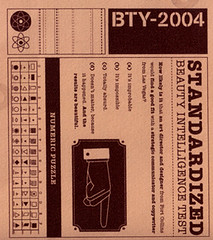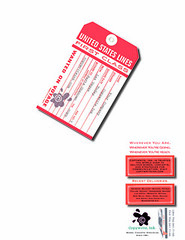I recenty read a story written by Amy Crane that reminded me most Americans don't realize that their right to privacy does not extend into the workplace.
In fact, she pointed out that according to the 2005 Electronic Monitoring and Surveillance Survey, conducted by the American Management Association and the ePolicy Institute, monitoring employees electronically is a growing part of the way American companies do business. The institute's survey, released in May 2005, noted that 76 percent of employers monitor workers' Web connections, while 50 percent store and monitor employees' computer files.
That's not all. Many companies go beyond keyboard keystroke monitoring, reviewing and storing employee e-mails and instant messages, monitoring time spent on the phone (or taping conversations). Video surveillance, drug testing,
and satellite technology that monitors use of company cars, cell phones and pagers are all becoming part of the mix.
While the invasion continues to move into other areas, company computer use is still the primary concern. According to the survey, 26 percent of employers have fired workers for workplace offenses related to the Internet and 25 percent of employers have fired employees for misuse of e-mail. While many employers monitor employees' Web surfing, a slightly smaller number - 65 percent of those surveyed - actually use software to block workers' access to inappropriate Web sites.
It's not all about productivity, employees who spend too much time online surfing, attending to personal business, or e-mailing friends. It's also about workers disclosing trade secrets or proprietary information over the Internet. And in some cases, employers have cause to worry.
When I recently conducted a blog workshop, I reminded a room full of communication managers that private conversations in the workplace with co-workers, vendors, or customers are a thing of the past. With the popularity of blogs, for example, anyone can be a journalist of sorts and share any experiences or comments with an audience as large as they're willing to capture.
I also added that it seems to me the real challenge is not really about employers and employees. It's about people. While some might scoff at the idea that they are being monitored at work, they feel perfectly justified in making private conversations public, recording personal chat logs and e-mails, positioning video monitors around and about their homes, and purchasing publications that reveal every dirty detail of someone's life if they happen to come into the public eye. In short, the enemy eroding our right to privacy is not a conspiracy constructed by faceless corporations and companies. On the contrary, companies are nothing more than a collection of people, which means the conspirators against privacy are us.
Good, bad, or indifferent, there are are simple solutions to avoiding serious problems. As an employee, be more sensitive to your company's privacy policies, avoid activities that violate them, and always be careful about with whom you share company information online and over the phone. For employers, even though the law does not require it, it's common sense to let employees know when, where, and how they might be monitored (about 80-89 percent of employers do). Otherwise, your company could inadvertently denigrate morale and trust in the workplace.
Of course, you don't have to have a company to be an employer. At home, you might consider extending the same courtesy to your babysitter, lawn care professional, and home improvement specialist. They're people too.
In fact, she pointed out that according to the 2005 Electronic Monitoring and Surveillance Survey, conducted by the American Management Association and the ePolicy Institute, monitoring employees electronically is a growing part of the way American companies do business. The institute's survey, released in May 2005, noted that 76 percent of employers monitor workers' Web connections, while 50 percent store and monitor employees' computer files.
That's not all. Many companies go beyond keyboard keystroke monitoring, reviewing and storing employee e-mails and instant messages, monitoring time spent on the phone (or taping conversations). Video surveillance, drug testing,
and satellite technology that monitors use of company cars, cell phones and pagers are all becoming part of the mix.
While the invasion continues to move into other areas, company computer use is still the primary concern. According to the survey, 26 percent of employers have fired workers for workplace offenses related to the Internet and 25 percent of employers have fired employees for misuse of e-mail. While many employers monitor employees' Web surfing, a slightly smaller number - 65 percent of those surveyed - actually use software to block workers' access to inappropriate Web sites.
It's not all about productivity, employees who spend too much time online surfing, attending to personal business, or e-mailing friends. It's also about workers disclosing trade secrets or proprietary information over the Internet. And in some cases, employers have cause to worry.
When I recently conducted a blog workshop, I reminded a room full of communication managers that private conversations in the workplace with co-workers, vendors, or customers are a thing of the past. With the popularity of blogs, for example, anyone can be a journalist of sorts and share any experiences or comments with an audience as large as they're willing to capture.
I also added that it seems to me the real challenge is not really about employers and employees. It's about people. While some might scoff at the idea that they are being monitored at work, they feel perfectly justified in making private conversations public, recording personal chat logs and e-mails, positioning video monitors around and about their homes, and purchasing publications that reveal every dirty detail of someone's life if they happen to come into the public eye. In short, the enemy eroding our right to privacy is not a conspiracy constructed by faceless corporations and companies. On the contrary, companies are nothing more than a collection of people, which means the conspirators against privacy are us.
Good, bad, or indifferent, there are are simple solutions to avoiding serious problems. As an employee, be more sensitive to your company's privacy policies, avoid activities that violate them, and always be careful about with whom you share company information online and over the phone. For employers, even though the law does not require it, it's common sense to let employees know when, where, and how they might be monitored (about 80-89 percent of employers do). Otherwise, your company could inadvertently denigrate morale and trust in the workplace.
Of course, you don't have to have a company to be an employer. At home, you might consider extending the same courtesy to your babysitter, lawn care professional, and home improvement specialist. They're people too.



















